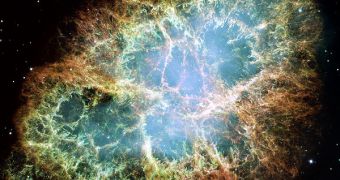Cosmic rays are streams of protons that occasionally slam into the planet's atmosphere at speeds close to that of light. While their effects have been identified and studied extensively, astrophysicists have had a hard time figuring out where they originate. A leading explanation is that supernovae somehow produce them, and a new study comes to confirm that, providing even more insight into the issue. The investigation highlights that the most likely origin for the rays are supernova remnants, the clouds of gas that remain after a star explodes at the end of its burning cycle, Space reports.
One of the most important features of remnants is the fact that they contain large shells of gas, which were created when the star that made them shed the outer layers of its atmosphere before exploding. These shells are permeated by large and powerful magnetic fields, which physicists now believe act like giant particle accelerators, causing gas particles to move extremely fast, before being ejected from the shells, and finally beginning their trip through space.
In the new research, the NASA Fermi Gamma-ray Space Telescope looked at a number of supernova remnants, and determined that they were emitting radiation that was up to a billion times more energetic than visible light. This radiation represents gamma-rays, the short-wavelength form of highly energetic light that astronomers consider to be the hallmark of cosmic rays. They say that it occurs when the fast-traveling rays collide with gas along their paths.
Experts add that younger supernovae are a lot more likely to be the source of cosmic rays, because they have the most powerful magnetic fields. This means that they can hold on to protons for enough time to accelerate them near the speed of light. Conversely, older supernovae have a diminished magnetic field, which means that they lose their ability to maintain a firm hold of particles over time.
“Understanding the sources of cosmic rays is one of Fermi's key goals. Fermi now allows us to compare emission from remnants of different ages and in different environments,” Stanford University Kavli Institute for Particle Astrophysics and Cosmology expert Stefan Funk says. He is also an astrophysicist at the SLAC National Accelerator Laboratory, in Menlo Park, California. “Older remnants are extremely bright in GeV gamma rays, but relatively faint at higher energies. Younger remnants show a different behavior. Perhaps the highest-energy cosmic rays have left older remnants, and Fermi sees emission from trapped particles at lower energies,” SLAC Panofsky Fellow Yasunobu Uchiyama adds.

 14 DAY TRIAL //
14 DAY TRIAL //